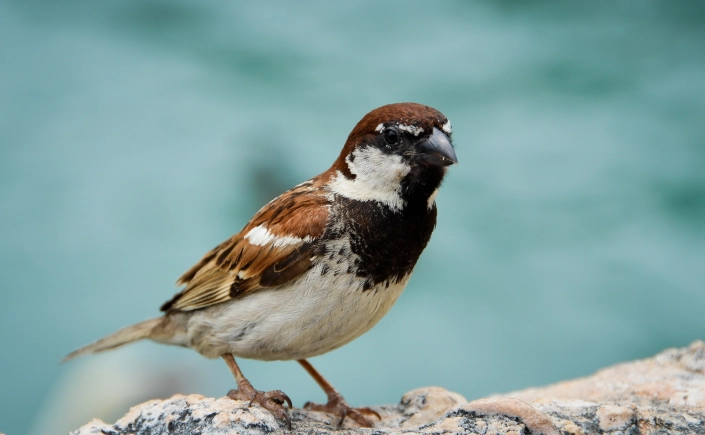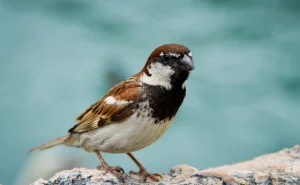In the bustling streets of urban landscapes, amidst the concrete jungle, there exists a seemingly innocuous yet remarkably pervasive avian species – the house sparrow (Passer domesticus). While often regarded as symbols of quaintness and urban charm, these feathered creatures harbor a complex interplay of ecological significance and socio-cultural implications. In this comprehensive discourse, we delve deep into the multifaceted realm of house sparrows, elucidating their ecological roles, behavioral patterns, and the intricate web of interactions they weave within their urban habitats.
Understanding the House Sparrow: Taxonomy and Distribution
Taxonomic Classification
Before delving into the intricate nuances of their behavior and ecological impact, it is imperative to grasp the taxonomic classification of the house sparrow. Classified under the phylum Chordata and the class Aves, house sparrows belong to the family Passeridae and the genus Passer. The species epithet, domesticus, aptly reflects their close association with human habitations.
Global Distribution
House sparrows boast a remarkable global distribution, owing much to their historical association with human settlements. Originating from the Middle East, these birds have spread far and wide, establishing thriving populations across various continents. Their adaptability to diverse environmental conditions has facilitated their successful colonization of urban, suburban, and even rural landscapes worldwide.
Ecological Role of House Sparrows: Seed Dispersers Extraordinaire

Seed Consumption and Dispersal Dynamics
House sparrows play a pivotal role as seed dispersers within their ecosystems, a role often overlooked amidst their ubiquitous presence in urban environments. Their voracious appetite for seeds, grains, and small insects contributes significantly to the dispersal of plant species, thereby influencing vegetation dynamics in urban habitats. By consuming and subsequently excreting seeds, house sparrows inadvertently aid in the colonization of new habitats by plant species, fostering biodiversity in the process.
Impact on Plant Community Composition
Studies have elucidated the profound impact of house sparrows on plant community composition within urban ecosystems. Through their selective foraging behaviors, these birds influence the abundance and distribution of plant species, thereby shaping the ecological dynamics of their habitats. While certain plant species may benefit from increased seed dispersal by house sparrows, others may face heightened competition, altering the overall structure and diversity of plant communities.
Behavioral Ecology of House Sparrows: Adaptations to Urban Environments
Nesting Behavior and Habitat Preference
One of the defining characteristics of house sparrows is their remarkable adaptability to urban environments, evident in their nesting behavior and habitat preference. Unlike their counterparts in rural settings, urban house sparrows exhibit a distinct preference for nesting sites in close proximity to human habitations. This behavioral adaptation underscores their remarkable plasticity in exploiting anthropogenic landscapes for their survival and reproduction.
Social Structure and Communication
House sparrows exhibit intricate social structures within their flocks, characterized by complex communication patterns and hierarchical arrangements. Through vocalizations, visual displays, and behavioral cues, these birds engage in intricate social interactions, facilitating cooperation and resource sharing within their communities. Such social dynamics play a crucial role in their foraging behavior, reproductive success, and overall fitness in urban environments.
Human-Wildlife Conflict: The Dark Side of Coexistence
Nuisance Behaviors and Public Health Concerns
Despite their seemingly innocuous presence, house sparrows are not without their share of nuisance behaviors and public health concerns. Their propensity to nest in human structures, coupled with their prolific breeding rates, often leads to conflicts with human inhabitants. Accumulation of droppings, damage to property, and potential transmission of diseases pose significant challenges in urban areas where human-wildlife interactions are frequent.
Mitigation Strategies and Conservation Efforts
Urban Planning and Habitat Management
In light of the myriad challenges posed by human-house sparrow interactions, effective mitigation strategies and conservation efforts are imperative to ensure harmonious coexistence. Urban planning initiatives aimed at creating bird-friendly habitats, such as green spaces, parks, and urban forests, can provide valuable refuge for house sparrows and other avian species. Additionally, habitat management practices, including nest box provision and vegetation management, can help mitigate conflicts and promote biodiversity conservation in urban landscapes.
Public Awareness and Community Engagement
Raising public awareness about the ecological importance of house sparrows and fostering community engagement are integral components of conservation efforts. Educational outreach programs, citizen science initiatives, and collaborative partnerships between local communities, conservation organizations, and governmental agencies can empower individuals to take proactive measures in safeguarding urban biodiversity. By fostering a sense of stewardship and appreciation for urban wildlife, we can collectively work towards creating sustainable urban ecosystems where humans and house sparrows thrive in harmony.
In conclusion, the intricate dynamics of house sparrows in urban ecosystems epitomize the complex interplay between humans and wildlife. While these avian inhabitants may pose challenges and conflicts in certain contexts, their ecological significance and cultural relevance cannot be understated. By adopting a holistic approach that integrates ecological understanding, behavioral insights, and conservation initiatives, we can foster harmonious coexistence between humans and house sparrows in urban landscapes. As stewards of our shared environment, let us strive to create inclusive and sustainable habitats where the melodious chirps of house sparrows resonate amidst the bustling rhythms of urban life.
Exploring the Socio-Cultural Significance of House Sparrows
Historical and Cultural Associations
Throughout history, house sparrows have been intertwined with human civilization, serving as symbols of familiarity and domesticity. From ancient folklore and mythological narratives to modern-day literature and art, these birds have left an indelible mark on human culture and imagination. In many cultures, the presence of house sparrows is often regarded as auspicious, symbolizing prosperity, companionship, and the joys of simple living. Their cheerful chirps and bustling activities evoke a sense of warmth and nostalgia, resonating with people across generations.
Symbolism in Literature and Art
The ubiquitous presence of house sparrows in urban landscapes has inspired countless poets, writers, and artists to immortalize their beauty and vitality in literature and art. From Shakespearean sonnets to contemporary novels, these birds have been portrayed as emblematic figures, embodying themes of resilience, adaptability, and the enduring spirit of urban life. In visual arts, depictions of house sparrows adorn canvases, murals, and sculptures, capturing their essence amidst the vibrant tapestry of city life. Through their artistic representations, house sparrows continue to evoke a sense of wonder and appreciation for the natural world amidst the concrete jungle.
Citizen Science and Community Engagement
In recent years, citizen science initiatives have emerged as powerful tools for engaging communities in wildlife conservation efforts, with house sparrows often serving as focal species for monitoring and research. Citizen science projects, such as bird counts, nest box monitoring programs, and habitat surveys, empower individuals of all ages and backgrounds to contribute valuable data on house sparrow populations and behaviors. By actively involving citizens in scientific inquiry and conservation action, these initiatives foster a sense of ownership and stewardship towards urban wildlife, laying the foundation for long-term sustainability and biodiversity conservation.
Challenges and Opportunities in Urban Conservation
While the presence of house sparrows in urban environments offers myriad opportunities for scientific inquiry and community engagement, it also presents significant challenges in terms of habitat loss, pollution, and human-wildlife conflicts. Rapid urbanization and habitat fragmentation pose threats to house sparrow populations, disrupting their nesting sites, foraging habitats, and social dynamics. Moreover, exposure to environmental pollutants, such as pesticides and air pollutants, can adversely affect their health and reproductive success, further exacerbating population declines.
Integrating Ecology and Design: Towards Bird-Friendly Cities
Addressing the conservation needs of house sparrows and other urban wildlife requires a holistic approach that integrates ecological principles with urban design and planning. Bird-friendly cities prioritize the creation of green spaces, biodiversity corridors, and wildlife-friendly infrastructure, providing essential habitat resources for house sparrows and other avian species. From green roofs and vertical gardens to wildlife-friendly building designs and urban wetlands, innovative solutions can enhance urban biodiversity while promoting human well-being and sustainability.
Harnessing Technology for Conservation
Advancements in technology, such as geospatial mapping, remote sensing, and acoustic monitoring, offer unprecedented opportunities for studying house sparrow populations and their habitats in urban landscapes. By leveraging these tools, researchers can gain valuable insights into the spatial distribution, movement patterns, and habitat preferences of house sparrows, informing targeted conservation strategies and management interventions. Additionally, citizen science platforms and mobile applications enable individuals to contribute real-time data on house sparrow sightings, behaviors, and habitat quality, facilitating collaborative efforts in urban wildlife monitoring and conservation.
Dynamics of House Sparrows
Related Post:
Unlocking the Egg-Laying Mystery: When Do Ducks Start Laying Eggs?
Choosing the Perfect Pet Duck: A Comprehensive Guide
Exploring the Enigmatic Ancona Duck: A Quirky, Beautiful, and Versatile Breed
As we navigate the complexities of urban life, the enduring presence of house sparrows serves as a poignant reminder of our interconnectedness with the natural world. Beyond their ecological roles and behavioral intricacies, these feathered denizens embody the spirit of resilience, adaptability, and coexistence amidst the ever-changing landscapes of urban environments. By embracing a holistic approach that integrates ecological understanding, cultural appreciation, and community engagement, we can forge a path towards sustainable urban futures where humans and house sparrows thrive in harmony. As guardians of our shared planet, let us embark on this journey with reverence, compassion, and a steadfast commitment to preserving the rich tapestry of life that surrounds us.



